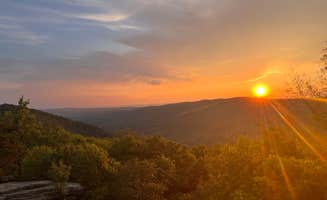Dispersed camping near Rohrersville, Maryland offers primitive outdoor experiences in the Mid-Atlantic region. The area sits within the Blue Ridge Mountains at elevations ranging from 400-1,000 feet, creating varied terrain for campers seeking rustic accommodations. Summer temperatures typically reach 85-90°F during day and drop to 60-65°F at night, while spring and fall bring cooler conditions with occasional precipitation that affects ground conditions at these undeveloped sites.
What to do
Fishing opportunities: Edwards Run Wildlife Management Area provides basic fishing experiences suitable for beginners. According to Frank G., "Fun place to teach the kids the basics of fishing, but the campground area leaves a little to be desired." The stream contains smaller fish but offers a low-pressure environment for learning.
Wildlife observation: The management areas near Rohrersville contain diverse bird species and small mammals. Early morning and dusk provide optimal wildlife viewing times, particularly along forest edges and near water sources. Bring binoculars and maintain distance from any animals encountered.
Photography: The natural landscapes surrounding rustic camping areas near Rohrersville offer photographic opportunities throughout the seasons. Morning fog in valleys and clear night skies create distinctive lighting conditions. Consider waterproof camera protection during spring camping when precipitation is more common.
What campers like
Solitude and quiet: Most primitive camping sites near Rohrersville provide significant distance from populated areas. Jim M. noted at Edwards Run Wildlife Management Area, "The site was level and grassy. Nice camp site." These locations typically see minimal traffic during weekdays.
Open camping layouts: Many sites feature open, grassy areas suitable for multiple tent configurations. Several locations offer both roadside accessibility and more secluded options further from parking areas.
Cost efficiency: The rustic camping areas maintain low fees compared to developed campgrounds. Jim M. observed, "As I pulled in there was a kiosk with a sign that said $10 camping fee but no info on how or where to pay." This payment confusion sometimes occurs at primitive sites with limited staffing.
What you should know
Self-sufficiency requirements: These primitive camping areas provide no potable water sources. Campers must pack in all drinking water, typically 1-2 gallons per person per day depending on activities and weather conditions. Water filtration from streams remains an option but requires proper equipment.
Access challenges: Better camping spots often require additional effort to reach. Frank G. explains, "There's a lot by the road that looks like it's where they want you to camp but there are better sites on in. Just gotta hike to em." Walking distances to interior sites typically range from 0.25-1 mile from parking areas.
Variable site conditions: Ground conditions at rustic camping near Rohrersville vary significantly with recent weather. Spring camping often encounters muddy conditions, while summer brings firmer, drier ground. Prepare for uneven terrain by bringing appropriate sleeping pads.
Tips for camping with families
Site selection priorities: When camping with children, prioritize sites with flat terrain and proximity to vehicles. Roadside sites provide easier access for gear transportation and quick departures if weather turns unfavorable.
Activity planning: Bring additional entertainment options for children as these primitive sites lack developed recreation areas. Simple activities like rock collecting, basic fishing, and guided nature observation keep younger campers engaged without electronic distractions.
Safety considerations: The rustic camping areas lack cell service in many locations. Establish clear boundaries for children and implement buddy systems for exploration. Pack a basic first aid kit suited for common outdoor injuries including insect bites and minor scrapes.
Tips from RVers
Site limitations: Most dispersed camping areas near Rohrersville accommodate smaller recreational vehicles only. Sites typically lack designated parking pads, hookups, and turnaround areas. Vehicle length restrictions generally limit RVs to under 25 feet.
Ground clearance requirements: Access roads to primitive camping areas often feature unpaved sections with occasional ruts or uneven surfaces. Higher-clearance vehicles navigate these conditions more effectively, particularly after rainfall.
Supply planning: With no services available, RVers must arrive fully stocked with water, propane, and other essentials. Plan for complete self-sufficiency with adequate tank capacity for your intended stay duration. Most campers bring 5-7 gallons of water per person for a weekend trip.


